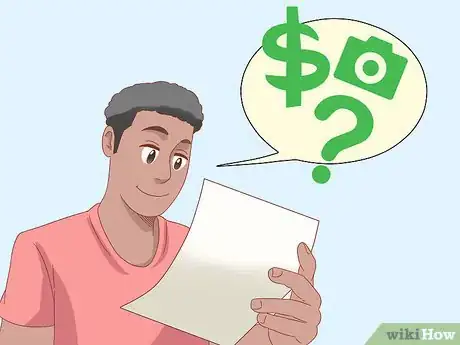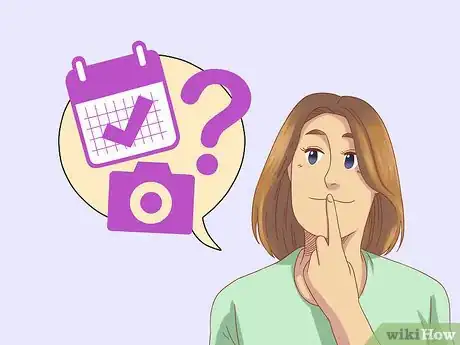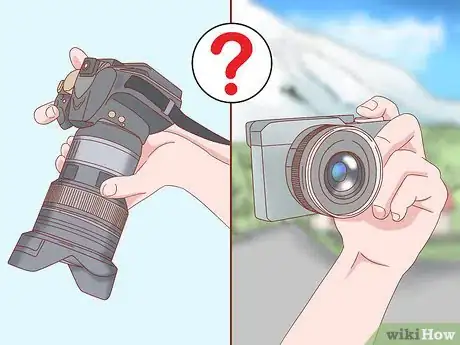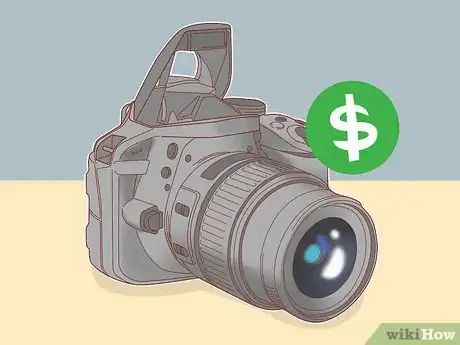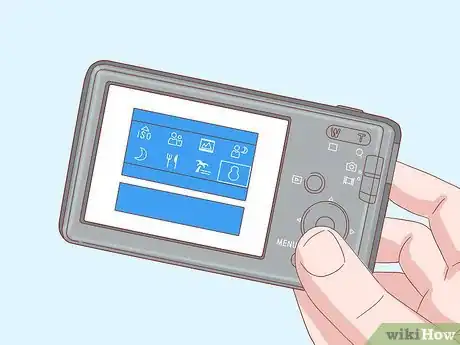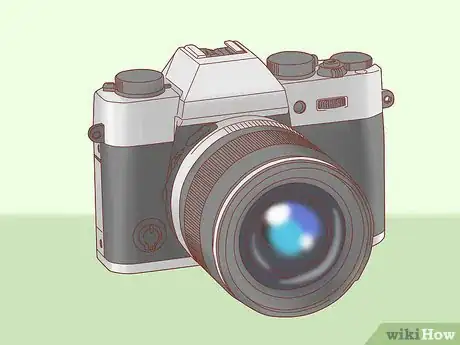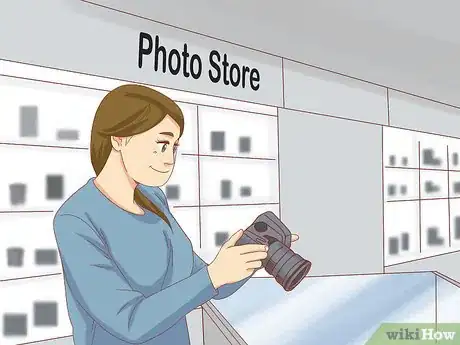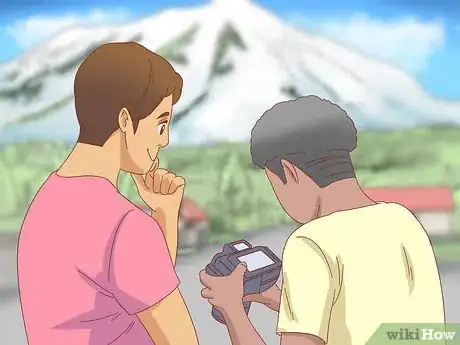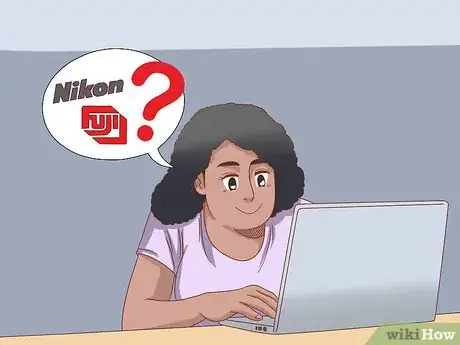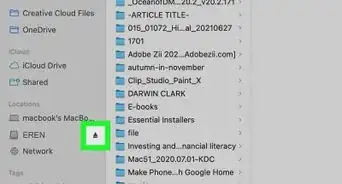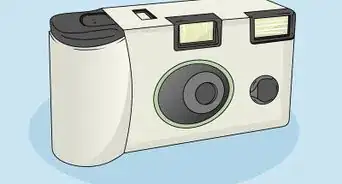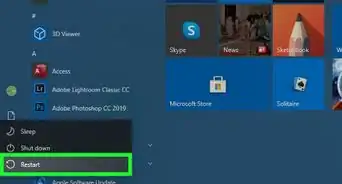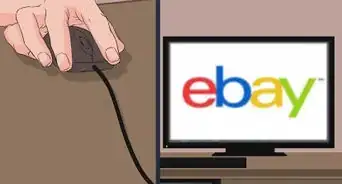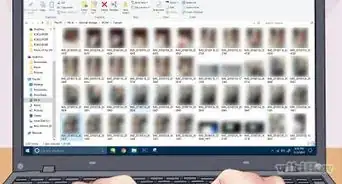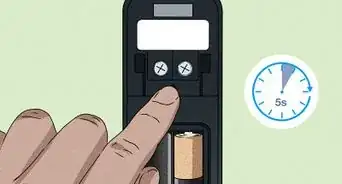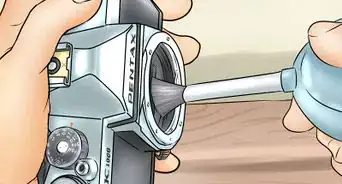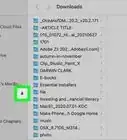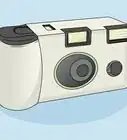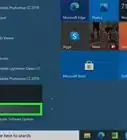This article was co-authored by Cory Ryan. Cory Ryan is a Professional Wedding Photographer who runs Cory Ryan Photography based in Austin, Texas. She has over 15 years of photography experience and specializes in weddings and events. Her work has been featured in publications such as The Knot, Style Me Pretty, and Junebug Weddings. She received a BA in Media Production and Broadcast Journalism from the University of North Carolina - Chapel Hill.
This article has been viewed 204,688 times.
Purchasing a camera is a big decision. The first step in choosing which type of camera to purchase is to decide on a realistic budget. Then, select a camera type. The main types are: DSLR (digital single lens reflex), point-and-shoot (also called “compact”) and mirrorless. Each type has its own advantages, based on what type of photography you plan on doing with the camera, and how often you'll use it.
Steps
Selecting a Price Range
-
1Decide how large of a budget you have for the camera. This is a good way to gauge what quality of camera you will be buying. Larger, fancier cameras with high resolution images and interchangeable lenses—like a DSLR—can cost over $1,000 USD, while cheaper point-and-shoot cameras can be as little as $150 USD.[1]
- A budget capped at $500 USD, for example, already excludes many cameras, and can help make your decision for you.
-
2Consider how often you'll use the camera. The best camera for you will vary based on whether or not you'll use the camera daily, monthly, or only a couple of times annually. The more you use the camera, the more it makes sense to invest hundreds of dollars in it.[2]
- If all you need is a camera for vacation snapshots, then a cheaper model might be better for you.
- If you'll use the camera at least once a week (whether as a hobbyist or for professional purposes) consider a more expensive mirrorless camera or a DSLR.
- Or, if you'll use the camera frequently, but photo quality isn't a high priority, you could purchase a mid-range compact camera.
Advertisement -
3Think about in what contexts you'll use the camera. A camera that's great for studio portraiture will not be a great camera to take on a hiking or backpacking trip. If you're planning on traveling with your camera or shooting outdoors, buy a camera that won't break the bank to replace. Likewise, if you're planning to shoot only high-quality indoor photos, opt for an expensive DSLR or mirrorless camera.[3]
- As a general rule of thumb, smaller, more compact cameras and cameras with fewer removable or interchangeable parts are best for traveling with.
Selecting a Type of Camera
-
1Purchase a DSLR if you're a serious hobbyist or a professional. DSLR—or digital single lens reflux—cameras are what many people think of when they picture a camera. DSLRs comprise a body and detachable lenses. This type of camera takes extremely high-quality pictures, which can be enhanced to tremendous sizes. They're not cheap though: a good DSLR can cost around $500 USD, while professional-quality models can cost over $1,200 USD.[4]
- Buying a high-quality DSLR allows you to purchase a variety of lens types—for example, wide angle, macro, or fish-eye—without having to purchase a new camera for each lens.
-
2Select a DSLR for complete control over the process of taking photos. With a DSLR, you have total control over the photograph. You can adjust the shutter speed alone, the aperture alone, change the ISO speed to whatever you want, or just use it like a large point and shoot. Unlike point and shoot cameras, you can use interchangeable lenses. This means that you have a wide range of lenses to choose from, depending on the manufacturer.[5]
- The downsides of DSLRs are that they are heavier and more expensive. They are also less practical to carry around.
-
3Buy a point-and-shoot if you'd like a cheap camera that's easy to use. Point and shoot cameras are just what they sounds like: you point your camera at the subject, zoom in or out, then press the button to take the picture. Such cameras require very little effort on the part of the photographer. They typically focus themselves and adjust themselves to light conditions.[6]
- One downside of the point-and-shoot style of camera is that, if you have any desire to capture fast moving kids or pets, the shutter lag of a point and shoot will make it impossible.
-
4Opt for a point-and-shoot if you want a bare-bones, inexpensive camera. Point-and-shoot cameras lack many of the bells and whistles of more expensive DSLRs. There are usually no manual controls, so have relatively little control over the output image. However, this isn't necessarily a bad thing: point-and-shoots produce good pictures and are good for casual, occasional photographers.[7]
- This type of camera also has the perk of being small: most point-and-shoots can easily fit in a small backpack or purse pocket, and many could fit in your pocket.
- Point-and-shoot compact cameras range in price from $200-400 USD.
-
5Buy a mirrorless camera for portability and relatively high quality. Mirrorless cameras can be substantially smaller than DSLRs, since their internal structure is different and they don't have a light-bouncing mirror structure. While these cameras don't offer image qualities quite as high as DSLR cameras, they still produce high-quality photos. Interchangeable lenses are another perk, which allows users to use different lenses in different settings.[8]
- Mirrorless cameras have various other names. Most frequently, they're called mirrorless interchangeable-lens cameras (MILC).
- MILCs start in the $300-400 USD range. Professional-level MILCs can cost as much as $4,000 USD.
-
6Select an analog (film) camera if you'd like a cheap, high-quality option. Now that a good number of hobbyists and professionals are going digital, film cameras have the advantage of being extremely cheap compared to a digital camera of the same quality. Film cameras do not have the same issues with visual noise as low-range digital cameras, though of course you get grain from the film. Nearly all film cameras are SLRs, and their quality is comparable to that of DSLRs.[9]
- Of course, using an analog camera brings many other expenses with it. You'll need to pay for film and for developing costs, unless you know someone with a darkroom and are prepared to learn how to develop your own B&W film. Developing film can get expensive if you're taking lots of photos.
- You can find decent, unused film cameras for $200 USD or less.
Comparing Cameras in Person
-
1Visit your local photo store and ask to try out some cameras. Once you have a rough idea of the type of camera you want, visit a photo shop and handle the cameras. With digital cameras, you can even snap a few shots right there in the store and see how you like it. It's important that you like how the camera feels in your hands, and that it feels natural to hold and shoot.[10] Consider:
- Is it too complicated? Will you avoid taking pictures because it's a pain?
- Feel the weight. Is it too heavy to carry around while on vacation?
-
2Ask friends or family members if you can try out their cameras. Especially if you're considering buying a $1,000+ USD camera, it's wise to try before you buy. Ask someone you know well if you can borrow their camera, and shoot a few dozen photos. Make sure you like the degree of control the camera gives you, as well as its size and feel.[11]
- If you know someone with a camera similar to one you'd like to buy, say something like, “Hi, I'm considering buying a camera just like yours, but would like to try out some of the features before I make the purchase. Would you mind if I try out yours for a couple of days?”
-
3Select a brand of camera to purchase. Most of the major camera brands—e.g., Camera, Nikon, and Fuji—all produce high-quality cameras. If you're purchasing a cheap point-and-shoot to use a few times a year, any brand will be fine. However, if you're buying a pro-level camera, you should do some research to figure out which brand—and which specific camera—best suits your needs.[12]
- Review the camera listings on various brands' websites, or speak to the sales staff in your local photography store to see which specific brands and cameras they'd recommend.
Expert Q&A
Did you know you can get expert answers for this article?
Unlock expert answers by supporting wikiHow
-
QuestionWhat is the best camera to buy for a beginner photographer?
 Cory RyanCory Ryan is a Professional Wedding Photographer who runs Cory Ryan Photography based in Austin, Texas. She has over 15 years of photography experience and specializes in weddings and events. Her work has been featured in publications such as The Knot, Style Me Pretty, and Junebug Weddings. She received a BA in Media Production and Broadcast Journalism from the University of North Carolina - Chapel Hill.
Cory RyanCory Ryan is a Professional Wedding Photographer who runs Cory Ryan Photography based in Austin, Texas. She has over 15 years of photography experience and specializes in weddings and events. Her work has been featured in publications such as The Knot, Style Me Pretty, and Junebug Weddings. She received a BA in Media Production and Broadcast Journalism from the University of North Carolina - Chapel Hill.
Professional Wedding Photographer
-
QuestionWhat camera would you recommend for someone who is a rookie in photography?
 Community AnswerDefinitely the Samsung wb200f. It was my first camera and lets you play around with manual mode, has great zoom, is really compact and easy to use.
Community AnswerDefinitely the Samsung wb200f. It was my first camera and lets you play around with manual mode, has great zoom, is really compact and easy to use. -
QuestionI want to be able to take a picture of the hummingbirds at our feeders from 300 feet away and blow it up to an 8 X10. What camera and lense do I need?
 ConnorFisherCommunity AnswerAny brand of high-quality DSLR or SLR should work well. As far as the lens goes, you'll need a telephoto or super telephoto.
ConnorFisherCommunity AnswerAny brand of high-quality DSLR or SLR should work well. As far as the lens goes, you'll need a telephoto or super telephoto.
References
- ↑ https://www.digitalphotomentor.com/choose-best-digital-camera/
- ↑ https://www.digitalphotomentor.com/choose-best-digital-camera/
- ↑ https://www.digitalphotomentor.com/choose-best-digital-camera/
- ↑ https://photographyconcentrate.com/camera-buying-guide-2/#types
- ↑ https://lifehacker.com/5822098/how-to-choose-the-perfect-camera-for-your-needs
- ↑ https://www.forbes.com/sites/jackforster/2013/07/21/yet-another-article-on-how-to-pick-a-camera-the-basics
- ↑ https://lifehacker.com/5822098/how-to-choose-the-perfect-camera-for-your-needs
- ↑ https://lifehacker.com/5822098/how-to-choose-the-perfect-camera-for-your-needs
- ↑ https://www.forbes.com/sites/jackforster/2013/07/21/yet-another-article-on-how-to-pick-a-camera-the-basics/
About This Article
To choose a camera, go with a point-and-shoot camera if you're looking for something cheap and easy to use. If you want more control over the photo-taking process, consider a DSLR, which will let you adjust things like shutter speed, aperture, and the lens you're using. A DSLR is a good choice if you're a serious hobbyist or a professional photographer. Or, if you have access to a darkroom or don't mind paying developing costs, get a film camera for a cheap, high-quality option. To learn how to shop for cameras in person, scroll down!
